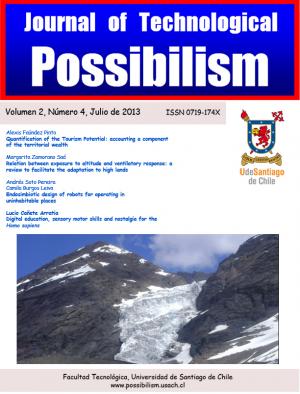Nº 4, Julio 2013
Quantification of the Tourism Potential: accounting a component of the territorial wealth - Alexis Faúndez Pinto - Download
- Abstract. In order to update and arrange the information about the physiological response to the increase in altitude, this article is a literature review. Despite the lack of systematic studies that cause uncertainty in decision making for the proper management of human resources, in general it is identified the fourth day as one when the adaptation process starts over 3000 meters. The results presented here may be useful for the mining industryin Andean countries where thousands of workers are intended to operate at high altitudes.
- Keywords: Tourism; Regional Development; Multiple Linear Regression; Tourism Demand; Tool; Potential.
Relation between exposure to altitude and ventilatory response: a review to facilitate the adaptation to high lands - Margarita Zamora Saá - Download
- Abstract. The Tourism Potential understood as a quantitative indicator of the maximum number of visitors that can attract a place of interest in a given time, supports decision making in various fields of territorial development. In this context, this work proposes amethod to quantify the Tourism Potential at Termas del Plomo y Glaciar el Morado, two sites located in Los Andes Mountains, close to Santiago de Chile. To achieve this purpose, the Tourist Potential was modeled as a function of some variables related to aspects such as: accessibility, advertising, services, population and climate restrictions. Since no data were available about visits to both sites, it was used as proxy, others five mountain ous sites where records did exist. Indeed, because all of them are under the state administration, they have data deal with the number of visits as a dependent variable; and infrastructure, facilities, demography and other as independent variables. Through a Multiple Linear Regression was able to discover the function that relates the number of visits to these explanatory variables, identifying advertising, travel costs and demographic attraction as the most relevant. The all these explanatory variables, the intervention is more plausible in travel costs, which reduced allow significantly increase the Tourist Potential, reaching 15406 visitors per year to glacier and 8846 visitors per year to baths. This preliminary work provides a quantitative and inexpensive tool for uncovering cryptic functions applicable to other similar places.
- Keywords: high altitude; hypoxia; barometric pressure; hyperventilation; acclimatization.
Endosimbiotic design of robots for operating in uninhabitable places - Andrés Soto Pereira y Camila Burgos Leiva - Download
- Abstract. This paper proposes a method of design emulating biological phenomena in artificial systems. The artifacts are robots that operate in inhospitable scenarios and the emulation is the synergistic partnership between a cell and heterotrophic bacteria phagocytosed by it. Through a simulation it can create an evolutionary process where the association between a creature that incorporates with in it self various elements of the universe, generates a new kind of robot. As in Nature, this sort of teleonomy with the apparent purpose fulness and goal-directed ness of structures and functions, it gets better the design process in industrial activities.
- Keywords: design; robot; endosimbiosis; teleonomy.
Digital education, sensory motor skills and nostalgia for the Homo sapiens - Lucio R. Cañete Arratia - Download
- Abstract. Current technology characterized by a rapid advance in information and communication systems not only facilitates homework completion but also in some cases turns out to be an almost indispensable tool. However, the recurrence of this technology atrophies in students certain abilities of the human specie such as the efficient array of several environmental elements in both weight and distance. Regarding that these natural abilities can help to achieve a harmonious ensemble with the environment and its effect is not inconsistent with the digital practices, this paper proposes the revitalization of traditional skills by means of workshops and ateliers for keeping in students of Secondary Education a high performance in the three dimensions of space and in time.
- Keywords: education, sensory motor, skill, Homo sapiens, environment, technology.

